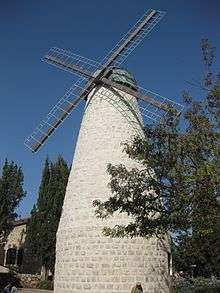Moses Montefiore
Sir Moses Haim Montefiore, 1st Baronet, FRS (24 October 1784 – 28 July 1885) was a British financier and banker, activist, philanthropist and Sheriff of London. Born to an Italian-Jewish family, he donated large sums of money to promote industry, business, economic development, education and health among the Jewish community in the Levant, including the founding of Mishkenot Sha'ananim in 1860, the first settlement of the New Yishuv. As President of the Board of Deputies of British Jews, his correspondence with the British consul in Damascus Charles Henry Churchill in 1841–42 is seen as pivotal to the development of Proto-Zionism.[1][2]
Sir Moses Montefiore | |
|---|---|
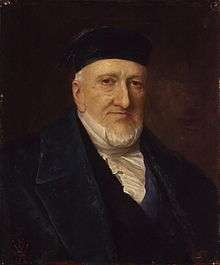 Sir Moses Montefiore painted in 1881 | |
| President of the Board of Deputies of British Jews | |
| In office 1835–1838 | |
| Preceded by | Moses Mocatta |
| Succeeded by | David Salmons |
| Personal details | |
| Born | 24 October 1784 Livorno, Tuscany, Holy Roman Empire |
| Died | 28 July 1885 (aged 100) Ramsgate, Kent, England |
| Spouse(s) | |
| Parents | Joseph Elias Montefiore Rachel Mocatta |
| Relatives | Abraham Mocatta (maternal grandfather) Levy Barent Cohen (father-in-law) |
| Occupation | Banker |
Early life
Moses Montefiore was born in Leghorn (Livorno in Italian), Tuscany, in 1784, to a Sephardic Jewish family based in Great Britain.[3] His grandfather, Moses Vital (Haim) Montefiore, had emigrated from Livorno to London in the 1740s, but retained close contact with the town, then famous for its straw bonnets. Montefiore was born while his parents, Joseph Elias Montefiore and his young wife Rachel, the daughter of Abraham Mocatta, a powerful bullion broker in London, were in the town on a business journey.[4]
Career
The family returned to Kennington in London, where Montefiore went to school, but because of his family's precarious situation, Montefiore did not complete his schooling and he went out to work to help with the family's finances.[5] He worked for a wholesale tea merchant and grocer and then entered a counting house in the City of London.[6] In 1803 he entered the London Stock Exchange, but lost all of his clients' money in 1806 in a fraud perpetrated by Elkin Daniels.[7] As a result, he probably had to sell or hand in his broker's licence.[8] In 1812, Montefiore became a freemason, joining the Moira Lodge, No. 92 of the Premier Grand Lodge of England in London.[9] Between 1810 and 1814 Montefiore was part of the Surrey Militia.[8] In 1815, he bought again a broker's licence, operated briefly a joint venture with his brother Abraham until 1816, and largely closed down his trading activities in 1820.[10]
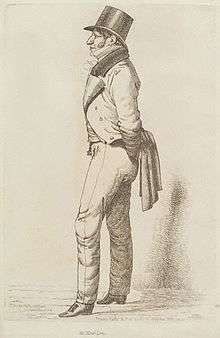
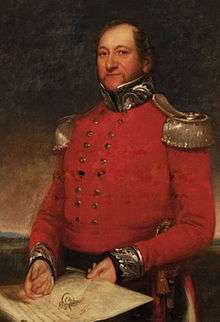
In 1812, Moses Montefiore married Judith Cohen (1784–1862), daughter of Levy Barent Cohen. Her sister, Henriette (or Hannah) (1783–1850), married Nathan Mayer Rothschild (1777–1836), for whom Montefiore's firm acted as stockbrokers. Nathan Rothschild headed the family's banking business in Britain, and the two brothers-in-law became business partners. In business, he was an innovator, investing in the supply of piped gas for street lighting to European cities via the Imperial Continental Gas Association. In 1824 he was among the founding consortium of the Alliance Life Assurance Company (which later merged with Sun Insurance to form Sun Alliance).[11]
Though somewhat lax in religious observance in his early life, after his visit to the Holy Land in 1827, he became a strictly observant Jew. He was in the habit of traveling with a personal shohet (ritual slaughterer), to ensure that he would have a ready supply of kosher meat.[12] Although Montefiore spent only a few days in Jerusalem, the 1827 visit changed his life.[13] He resolved to increase his religious observance and to attend synagogue on Shabbat, as well as Mondays and Thursdays when the Torah is read. The visit had been a "spiritual transforming event" for him.[13]
In 1831, Montefiore purchased a country estate with twenty-four acres on the East Cliff of the then fashionable seaside town of Ramsgate. The property had previously been a country house of Queen Caroline, when she was still Princess of Wales. It had then been owned by the Marquess Wellesley, a brother of the Duke of Wellington.[14] Soon afterwards, Montefiore purchased the adjoining land and commissioned his cousin, architect David Mocatta, to design a private synagogue, known as the Montefiore Synagogue. It opened with a grand public ceremony in 1833.[14]
Montefiore is mentioned in Charles Dickens' diaries, in the personal papers of George Eliot, and in James Joyce’s novel Ulysses. It is known that he had contacts with non-conformists and social reformers in Victorian England. He was active in public initiatives aimed at alleviating the persecution of minorities in the Middle East and elsewhere, and he worked closely with organisations that campaigned for the abolition of slavery. A Government loan raised by the Rothschilds and Montefiore in 1835 enabled the British Government to compensate plantation owners under the Slavery Abolition Act 1833 and thus abolish slavery in the Empire.[15]
In 1836 he became a governor of Christ's Hospital, the Bluecoat school, after assisting in the case of a distressed man who had appealed to Montefiore to help his soon-to-be-widowed wife and son.[16] Physically imposing at 6 ft 3 in (1.91 m), he was elected Sheriff of the City of London in 1837.[17] He was also knighted in November 1837.[18]
Retirement
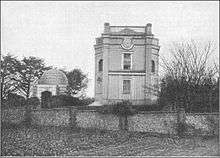
After retiring from business, Montefiore devoted the rest of his life to philanthropy.[19] He was president of the Board of Deputies of British Jews from 1835 to 1874, a period of 39 years, the longest tenure ever, and member of Bevis Marks Synagogue. As president, his correspondence with the British consul in Damascus Charles Henry Churchill in 1841–42 is seen as pivotal to the development of Proto-Zionism.[1][2]
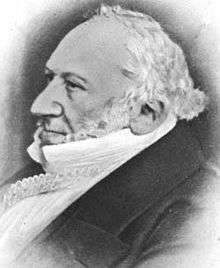
From retirement until the day he died, he devoted himself to philanthropy, particularly alleviating the distress of Jews abroad. He went to the sultan of the Ottoman Empire in 1840 to liberate from prison ten Syrian Jews of Damascus arrested after a blood libel; to Rome in 1858 to try to free the Jewish youth Edgardo Mortara, who had been seized by the Catholic Church after an alleged baptism by a Catholic servant; to Russia in 1846 (where he was received by the Tsar) and 1872; to Morocco in 1864 and to Romania in 1867. It was these missions that made him a folk hero of near mythological proportions among the oppressed Jews of Eastern Europe, North Africa and the Levant.[20]
He received a baronetcy in 1846 in recognition of his services to humanitarian causes on behalf of the Jewish people.[21]
Philanthropy in Ottoman Palestine
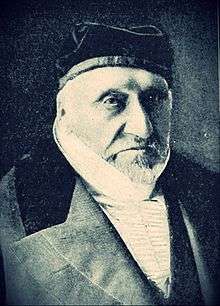
| Old Yishuv |
|---|
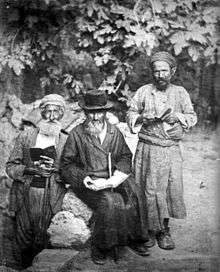 |
| Key events |
|
| Key figures |
|
| Economy |
| Philanthropy |
| Communities |
| Synagogues |
| Related articles |
In 1854 his friend Judah Touro, a wealthy American Jew, died having bequeathed money to fund Jewish residential settlement in Palestine. Montefiore was appointed executor of his will, and used the funds for a variety of projects aimed at encouraging the Jews to engage in productive labor. In 1855, he purchased an orchard on the outskirts of Jaffa that offered agricultural training to the Jews.[22]
In 1860, he built the first Jewish residential settlement and almshouse outside the old walled city of Jerusalem, today known as Mishkenot Sha'ananim. This became the first settlement of the New Yishuv. Living outside the city walls was dangerous at the time, due to lawlessness and bandits. Montefiore offered financial inducement to encourage poor families to move there. Montefiore intended Mishkenot Sha’ananim to be a new type of self-sufficient, sanitary settlement where Sephardi and Ashkenazi Jews lived together.[23] Later on, Montefiore established adjacent neighborhoods south of Jaffa Road, the Ohel Moshe neighborhood for Sephardic Jews and the Mazkeret Moshe neighborhood for Ashkenazi Jews.[24]
Montefiore donated large sums of money to promote industry, education and health amongst the Jewish community in Palestine. The project, bearing the hallmarks of nineteenth-century artisanal revival, aimed to promote productive enterprise in the Yishuv. The builders were brought over from England. These activities were part of a broader program to enable the Old Yishuv to become self-supporting in anticipation of the establishment of a Jewish homeland.[25]
Montefiore built the Montefiore Windmill in an area which later became the Yemin Moshe neighbourhood, to provide cheap flour to poor Jews, established a printing press and textile factory, and helped to finance several Bilu agricultural colonies. He also attempted to acquire arable land for Jewish cultivation, but was hampered by Ottoman restrictions on land sale to non-Muslims. The Jews of Old Yishuv referred to their patron as "ha-Sar Montefiore" ('The Prince' or simply 'Prince' Montefiore), a title perpetuated in Hebrew literature and song.[26]
A major source of information about the Yishuv, or Jewish community in Palestine during the 19th century, is a sequence of censuses commissioned by Montefiore, in 1839, 1849, 1855, 1866 and 1875. The censuses attempted to list every Jew individually, together with some biographical and social information (such as their family structure, place of origin, and degree of poverty).[27]
Later life and death
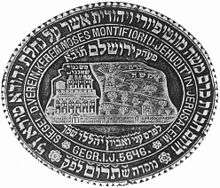
Montefiore played an important role in Ramsgate affairs, and one of the local ridings still bears his name. In 1845 he served as High Sheriff of Kent.[28] In 1873, the year of his 89th birthday, a local newspaper mistakenly ran his obituary. "Thank God to have been able to hear of the rumour", he wrote to the editor, "and to read an account of the same with my own eyes, without using spectacles."[29]
The town celebrated his 99th and his 100th birthdays in great style, and every local charity (and church) benefited from his philanthropy. At East Cliff Lodge, he established a Sephardic yeshiva (Judith Lady Montefiore College) after the death of his wife in 1862. In the grounds he built the elegant, Regency architecture Montefiore Synagogue and mausoleum modeled on Rachel's Tomb outside Bethlehem (whose refurbishment and upkeep he had paid for). Judith was laid to rest there in 1862.[30]
Montefiore died in 1885, at age 100. He had no known children, and his principal heir in both name and property was a nephew, Joseph Sebag Montefiore.[31] The philanthropist Leonard Montefiore was a grand nephew of Montefiore.[32] British historian Simon Sebag Montefiore, Moses Montefiore's distant nephew, revealed that his family believes Sir Moses to have fathered a child with a 16-year-old domestic servant, late in his life.[33] Montefiore himself was buried in the Montefiore Synagogue at Ramsgate.[34]
The estate was sold to the Borough of Ramsgate around 1952, and the Lodge was demolished in 1954. All that remains today is a new building housing a firm of architects which incorporates parts of the original structure, called the Coach House. There are also some outbuildings (including the Gate House) and the Italianate Greenhouse has been restored to its former glory in recent years. The Greenhouse and the rest of the estate has been turned into King George VI Memorial Park. On the Gate House, is a plaque to Sir Moses.[35]
Legacy
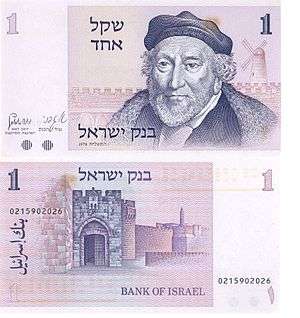
The Montefiore Medical Center in the Bronx, New York, is named for him.[36] Montefiore Square, a small, triangular park in upper Manhattan's Hamilton Heights neighborhood, is named for Montefiore Medical Center, which was formerly located to the north of the park at West 138th Street.[37]
A branch of the University of Pittsburgh Medical Center in Pittsburgh, Pennsylvania, also bears his name. Chicago's West Side is home to a reform school of higher education, Moses Montefiore Academy, named in honor of him.[38]
A number of synagogues were named in honor of Montefiore, including the 1913 Montifiore Institute, now preserved as the Little Synagogue on the Prairie.[39]
The Montefiore Club was a private social and business association, catering to the Jewish community, located in Montreal, Quebec, Canada.[40]
In Cleveland, Ohio one of the Jewish nursing homes is called Montefiore.[41]
In Israel, Montefiore is commemorated in several cities by streets named after him, as well as the neighborhoods of Kiryat Moshe, Zikhron Moshe, Yemin Moshe, Ohel Moshe (now Nachlaot), and Mazkeret Moshe in Jerusalem, and Montefiore in Tel Aviv. He was also commemorated on two Israeli banknotes. These were the 10 lirot, which was in circulation from 1970–79,[42] and the 1-shekel, which was legal tender from 1980 to 1986.[43]
The Dolphin's Barn Jewish cemetery in Dublin, Ireland, is dedicated to Montefiore.[44]
Anecdotes
Montefiore was renowned for his quick and sharp wit. A popularly circulated anecdote, possibly apocryphal, relates that at a dinner party he was once seated next to a nobleman who was known to be an anti-Semite. The nobleman told Montefiore that he had just returned from a trip to Japan, where "they have neither pigs nor Jews." Montefiore is reported to have responded immediately, "in that case, you and I should go there, so it will have a sample of each" (a similar anecdote is told of Israel Zangwill.)[45]
Coat of arms
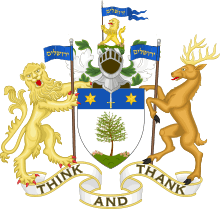 |
|
See also
- History of the Jews in England
- Mazkeret Moshe, Zikhron Moshe, Kiryat Moshe, and Yemin Moshe, neighborhoods in Jerusalem which bear his name
- Montefiore, Tel Aviv, another neighborhood named after him
- Montefiore Windmill, windmill in Jerusalem, erected due to Montefiore
References
- Adler, Joseph (1997). Restoring the Jews to their homeland: nineteen centuries in the quest for Zion. J. Aronson. pp. 150–6. ISBN 1-56821-978-4. Retrieved 19 January 2011.
- Wolf, Lucien (1919). "Notes on the Diplomatic History of the Jewish Question with texts of protocols, treaty stipulations and other public acts and official documents,". the Jewish Historical Society of England.
- Levine, Menachem. "Sir Moses Montefiore – A Brief History". Aish. Retrieved 12 December 2018.
-

- Moshe Samet, "Moses Montefiore – Reality and Myth", Carmel, 1989, 20–22 (in Hebrew).
- Abigail Green, Moses Montefiore, 2010, 25.
- Green 2010, 26–27.
- Samet 1989, 23.
- "Jews in English Freemasonry". Jewish Communities and Records. 20 April 2015.
- Samet 1989, 27.
- "Records of Sun Fire Office". National Archives. Retrieved 19 April 2020.
- Goodman 1925, p. 214
- "Judith Montefiore's Private Journal (1827): Jerusalem and Jewish Memory". Imperfect Sympathies. pp. 105–132.
- "The Montefiore Synagogue and Mausoleum at Ramsgate - Sir Moses Montefiore". montefioreendowment.org.uk. Retrieved 9 October 2015.
- "Bank of England apologises for role of former governors linked to slave trade". Fintech Futures. 23 June 2020. Retrieved 15 July 2020.
- Christ's Hospital, The Observer 1 February 1836 p 3
- Barton, Henry D. (1840). Analytical Digest of Cases Published in the Law Journal, Volume 9, Part 2. E.B. Ince.
- "No. 19558". The London Gazette. 14 November 1837. p. 2922.
- "History Cooperative - A short history of nearly everything!". historycooperative.org. Archived from the original on 1 August 2012. Retrieved 9 October 2015.
- Sebag Montefiore, Simon (2016). The Romanovs. United Kingdom: Weidenfeld & Nicolson. p. 373.
- "No. 20618". The London Gazette. 30 June 1846. p. 2391.
- "The Mountain of Despair". Haaretz.com. Retrieved 9 October 2015.
- "Jewish Communities in Jerusalem". Parallel Histories. Retrieved 19 February 2020.
- "Colonel Charles Henry Churchill's letter to Sir Moses Montefiore, a first in supporting a Jewish state in Palestine". Jerusalem Post. 26 June 2018.
- Levine, Rabbi Menachem. "Sir Moses Montefiore: A Brief History". Aish.com. Retrieved 12 December 2018.
- Birnbaum, David (2012). Jews, Church & Civilization, Volume V: 1822 CE-1919 CE. New Paradigm Matrix. p. 31. ISBN 978-0984361915.
- Kessler, Daniel (2016). "The Jewish community in nineteenth century Palestine: evidence from the Montefiore censuses". Middle Eastern Studies.
- "No. 20439". The London Gazette. 4 February 1845. pp. 315–316.
- Green, Abigail (2010). Moses Montefiore: Jewish Liberator, Imperial Hero. Cambridge, MA. ISBN 9780674064195.
- Goodman 1925, p. 127
- "Montefiore". London Times. 5 September 1885. p. 9f.
The Queen has granted to Mr. Joseph Sebag, nephew and residuary legatee of the late Sir Moses Montefiore, and his successor in the East Cliff estate, Ramsgate, her Royal licence to use the surname of Montefiore after his own paternal name, and to bear Sir M. Montefiore's arms.
- "Montefiore". Jewish Encyclopedia.
- Sebag Montefiore remarks at http://c-spanvideo.org/program/303145-1
- Goodman 1925, p. 211
- "Archived copy". Archived from the original on 24 March 2012. Retrieved 11 May 2011.CS1 maint: archived copy as title (link)
- "The Home for Chronic Invalids". The New York Times. 27 October 1884. p. 5. Retrieved 24 October 2018.
- Moscow, Henry (1990). The Street Book. Fordham University Press. p. 77.
- VICE News (4 April 2014). "Expelled From Every Other School: Last Chance High (Episode 1)". Retrieved 28 January 2017 – via YouTube.
- Rhonda Spivak (31 July 2008). "A synagogue lost then found" (PDF). UpFront. p. 32. Archived from the original (PDF) on 17 February 2012.
- "Montefiore Club". ManilaClub.org. Archived from the original on 27 July 2011. Retrieved 28 January 2017.
- "Non-Profit Nursing Home | Jewish Assisted Living | Montefiore". www.montefiorecare.org. Retrieved 25 July 2018.
- "10 lirot banknote..."
- "Error-2010-f5". BankIsrael.gov.il. Retrieved 28 January 2017.
- Erwin R. Steinberg. "James Joyce and the Critics Notwithstanding, Leopold Bloom Is Not Jewish". Journal of Modern Literature, Vol. 9, No. 1 (1981–1982), pp. 27–49
- Novak, William. The Big Book of Jewish Humor. Harper, 1981. p. 83.
- "Armorial families : a directory of gentlemen of coat-armour". archive.org. Retrieved 9 October 2015.
Bibliography
- Goodman, Paul (1925). Moses Montefiore (PDF). The Jewish Publication Society of America.
- Green, Abigail (2010). Moses Montefiore: Jewish Liberator, Imperial Hero. Cambridge, MA. ISBN 9780674064195.
- Jaffe, Eliezer David (1988). Yemin Moshe – The Story of a Jerusalem Neighborhood. New York: Praeger and Greenwood Press.
- Samet, Moshe (1989). Moses Montefiore - Reality and Myth (in Hebrew). Carmel.
- Wolf, Lucien (1885). Sir Moses Montefiore: a Centennial Biography. Harpers Brothers.
External links
| Wikimedia Commons has media related to Moses Montefiore. |
- Website of the Montefiore Endowment at Ramsgate
- The Sir Moses Montefiore & Lady Judith Montefiore Heritage Site
- Photos of Yemin Moshe

- Diaries of Sir Moses and Lady Montefiore
- "Montefiore, Sir Moses Haim". Encyclopædia Britannica. 18 (11th ed.). 1911. p. 765.
- The Montefiore Home
- Works by Moses Montefiore at Project Gutenberg
- Works by or about Moses Montefiore at Internet Archive
